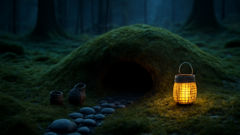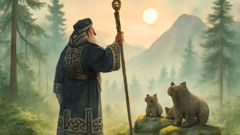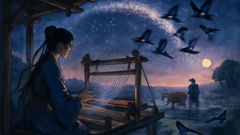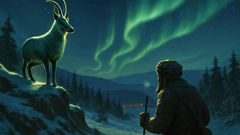Introduction
On the island's northern edge, where the sea wind carries salt and the mountains lean close like an attentive neighbor, the Ainu told stories that folded the living world and the unseen into the same breath. Among those stories, repeated by hearth and by river, by mothers tucking wraparound hair and by elders whose fingers never stopped tracing the lines of maps fashioned out of memory, one name was always spoken softly: Korpokkur. They were the small ones—shy, fleet, and skilful—who lived beneath the earth and in the shadow of the roots. They rose, the storytellers said, through a film of moss and loam, trading fishhooks and woven goods for dried salmon and rice. They left no footprints the size of a human's, only the impression of generosity: a mote of oil, a set of fine tools, a shell polished and left at the hearth corner. Sometimes a child peering under a log glimpsed a flash of cloth; sometimes a woman heard the whisper of tiny footsteps under the floorboards and smiled without starting, for the Korpokkur kept to their bargains and to their mystery. The Ainu taught ways of listening—to the wood, to the river, to the hum beneath the moss. Those who listened knew when the air tasted of a trade about to be made. But with that knowledge came rules. You could not accept a gift without leaving something of equal worth in return; you could not speak their names too loudly or pry too deeply into their ways; you could not try to bring them fully into the daylight lest both worlds fray. This story is a careful retelling of those rules and intimacies: of the bargains struck in the hush of snow and spruce, of a fragile friendship between a human child and a Korpokkur artisan, and of the moment when curiosity bent toward possession. It is a tale of how respect and restraint kept two worlds in balance, and how a single breach, once made, echoes in the moss for generations. As you walk these pages, imagine cold river water up to the knee, the pungent burn of charred fish, the scent of damp cedar, and a presence that watches from roots and rocky hollows—small hands working in secret, eyes like sunlit amber, and the exacting wisdom of those who live beneath the floor of the forest.
Of Bargains and Moss: Origins and Ways
The oldest songs say the Korpokkur came when the world was still young and nimble. Some elders spoke of them as the offspring of mountain breeze and river clay, others as kin to the spirits that guided salmon upriver. Their stature, when one dared to say it aloud, was smaller than a child’s knee but larger than a bird’s. They had hands that understood fine work: they could weave a reed into a net with the patience of someone who had watched tides for centuries; they could cut a bead of bone so fine it seemed a sliver of moon. Most of all, they knew how to trade. They were the original subterranean traders—a reciprocal people with an economy written in the currency of favors, sustenance, and the quiet exchange of small objects. Trade did not proceed by contract in the way humans bind themselves with words. It proceeded by ritual and attention: a dish of steaming fish placed at the edge of a hearth, a small pile of millet, a bright shell left polished—these acts were invitations that the Korpokkur read at once. In return they left tools—delicate awls, pins of copper and bone, tiny pots glazed with an earthy sheen—and sometimes seeds of rare herbs. The gifts were precise. Nothing bulky. Nothing ostentatious. An exchange balanced itself like a careful scale. Communities that honored this balance believed their nets returned fuller, their smokehouses preserved more cleanly, and the children’s coughs grew lighter when the Korpokkur’s favor rested upon a household.
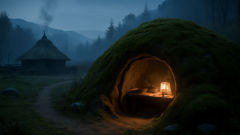
The Korpokkur’s dwellings were both intimate and complex. They lived where moss grew so thick the forest floor seemed cushioned against the world’s noise, where roots created small arches like the ribcage of the land. Under such grooved mounds the air smelled of earth and an odd sweetness—compost, fermented sap, and dry moss. Their rooms were tiny living lessons: shelves of polished pebbles, a line of miniature drying racks, and tools hung on the inside of bark-curved walls. Tailored to bodies that moved with the economy of smallness, their architecture was efficient and secretive. A stone might be set so that it rolled by the lightest nudge into place and hid an entrance. A hollowed root could be a tunnel that led to a network of chambers beneath any given village. Those who taught about the Korpokkur insisted their homes were less a challenge of discovery than a test of listening; only the patient and the respectful could ever enter or even be given a hint of the route.
There were rules, as there are in any polity, but these were rules of relationship rather than law. Accept a gift and reciprocate; take only what is offered; never seek them by force; do not try to keep them in the open; do not look at the Korpokkur while they sleep; do not name them loudly if you would preserve the veil. Breaking those rules invited misfortune that could be small—some fish that rotted on the line—or terrible—blights on the harvest, nights when wolves came closer than they ought. The moral logic of the old stories is consistent: the world runs on mutual respect, and the smallest beings are as essential as the tallest. Elders used tales of bargain and balance to teach children restraint. They taught that possession without gratitude unravels generosity, and that greed is a blunt instrument against economies of care.
A consistent thread through the stories is the Korpokkur's craftsmanship. They made objects of singular finesse: fishhooks balanced to the precision of a fly’s wing, tiny spoons hewn from ivory, and stone beads so smooth a child could not stop running thumbs over them. These were not only practical items but symbols—tokens that bound the human household to the subterranean one. When an Ainu household found a Korpokkur gift, it was often wrapped in bark or hidden in a hollow; it would be placed on the family altar or near the hearth as a reminder of the bargain fulfilled. To receive such an object was to accept a tie, visible or invisible, to a world that lived beneath and beside human affairs.
Storytellers also speak of special exchanges performed at particular times: spring when the snow softens and roots breathe again; autumn when salmon ran and skins were flensed; and nights when the moon sat like a coin above the pines. Bargains struck on those nights felt weightier, their echoes larger. A family might leave a braided cord of dried fish and in the morning find a tiny set of carved wooden combs, each with teeth as fine as needles. Another night might see the Korpokkur leave the seeds of a hardy herb that cured fever. In those reciprocity-centered tales, both parties benefited: the Korpokkur received food for their households; humans received tools and talismans.
Yet the Korpokkur were not simple benefactors. They were unpredictable in human terms, their moods shifting like weather. An insult—an accidental or deliberate slight—could see a gift left out for them vanish or become tarnished. A proud or greedy person who tried to keep a Korpokkur’s gift for themselves found that it became heavy in their hands, useless at the net or oven, until they mended the wrong by returning something of equal care. The elders framed these lessons with a patient authority: the cosmos is not a machine to be exploited; it is a conversation to be maintained. To listen was to inhabit the humble posture of one willing to be altered by the world.
Of course, not all contact was gentle. There are tales of children who snuck into the mossy mounds and peered too closely, only to find themselves covered in a luminous dust and returned to their households with memories that wouldn't come together in the daylight. There are stories of hunters who followed tiny footprints to traps that hardly seemed to belong to the earth. Yet even these dangerous encounters are narrated with a tone of caution rather than demonization: the forest has rules, and the Korpokkur are part of them. Violence rarely ends well in these stories; it collapses the bridge the two peoples maintained. The lesson, reiterated by countless tellers beside countless fires, was as practical as it was spiritual: live with humility, give where you can, and keep the quiet pacts that sustain the fragile commonwealth between people and those who dwell beneath them.
A Child and a Craftsman: A Story of Friendship and Breach
There was once a village that lay along a narrow river, its houses spaced like a bead necklace, each one with its own low, faithful hearth. The people there honored the old practices: they left small plates at the threshold on nights when the river was particularly generous, and they spoke softly of the Korpokkur, with the kind of reverence that makes speech both regular and rare. In that village lived a child named Aipa. She had hair like raven feather and the curiosity of someone born with too many questions. She watched fishermen mend nets with the same intensity she used to watch ants at work. She would sit for hours beside elders, fingers restless, listening to the cadence of old stories and learning the rules as if reciting prayers.

One spring when the snow had just a few crusts left and the river grew louder with melt, Aipa found something carved and small beneath a floorboard she’d been prying to find a lost bead. It was a tiny awl, no longer than her thumb, carved from the bone of a sea bird. Its tip was honed so fine that for a moment Aipa thought it would pierce the wind itself. She knew the rules. She had learned them like a litany: never remove a thing without leaving something; if you find a gift, do not pocket it like an ordinary prize. But the awl was beautiful and perhaps, she told herself, it was meant for her small, quick hands. The house was asleep; the hearth only glowed. The nagging voice of every elder in the village told her to leave something in return, but Aipa, being a child with a hunger for objects that echoed her appetite for stories, tucked the awl inside her sash and crept out into the night.
At first nothing happened. The next morning, her grandmother praised her quickness at mending nets, for with the tiny awl Aipa stitched a delicate repair no one in the house could have made so finely. She was proud and secretive in a way that tasted like victory. But victory in the tales often comes wrapped in warning. As the following days passed, small discomforts accrued: the smoke in the hearth burned more densely, honey fermented oddly, and the family’s dog—steady and old—refused to cross the threshold never again. Aipa felt a tightening in her chest, a knowledge she couldn't name pressing like a cold palm. At night she would wake to the faint sound of tiny footsteps along the beam above her head—an old sound in the village that used to be reassuring but now felt like an accusation.
Guilt, in stories and in life, has an exacting way of unspooling. Aipa kept the awl neatly wrapped, but she could not sleep. The shame of the stolen gift grew until she could no longer pretend it would vanish like morning fog. She told her grandmother in the end—not all her story, because children guard certain details even when they repent, but enough. Her grandmother listened and sighed, and then she did what the elders had done for generations: she taught Aipa how to prepare a proper return.
They took a small pouch of seeds—her grandmother’s best, saved for the right soil—and wrapped them in cedar bark. They also prepared a bead of polished shell, carved with the faint image of a river, and a soft stitchwork of gratitude in thread that smelled of smoke and earth. Under the moon they approached the moss mound where the awl had been taken. They set the pouch near the entrance, placed the bead on top, and said the words of an old apology loud enough for the mound to hear but soft enough not to call the Korpokkur by more than their necessary name. Then they retreated. When they returned the next day, the pouch was still there. So was the bead. In its place, on the hearth, lay a second awl—no different from the first but new as if it had never been used. The household felt relief like a light breathed back into a lamp.
The elders who told this story always emphasized the texture of the trade: the precise mixture of humility and action. Aipa’s family had not been ruined because they had chosen to mend, to acknowledge, to give back. More than that, the children’s curiosity had been preserved, not crushed, because it had been channeled into care. Aipa learned to listen with a steadier ear, to leave her small gifts at thresholds, and to watch the forest with a near-sacred patience. But the tale includes, too, the counterexamples: of a man who, angry that a Korpokkur gift seemed too small, tried to capture one with a net and a clever trap. He failed. The trap drew the ire of the subterranean people, and his house was visited for nights by a chorus of tiny knocks that tightened the household's sleep until they slept no more. The moral was never merely punitive: it taught that relationships require practices, that absence of care corrodes even the best of boundaries.
Aipa’s incident, retold over seasons, took on layers of meaning. For children who heard it by lantern light, it was an adventure: the thrill of a stolen treasure and the drama of returning it. For adults, the story served as a framework for social memory. It encoded a method: if you err, act with humility and repair the bond with care. It encoded a cosmology: small beings inhabit the world as we do and deserve the same honor. The lesson is intimate and practical, designed to be lived rather than merely recited. We carry the imprint of such tales in the way we leave gifts on thresholds, in the way we name our obligations and in the way we teach children that some mysteries are not ours to possess.
Yet the story does not end with a simple restitution. There are later chapters—told by those who loved complexity—where Aipa grows into a woman who becomes an artisan in her own right. She learns the Korpokkur’s patterns of weaving, not by stealing them but by observing the flows of wind across rivergrass and by making offerings that opened the smallest doorways. In time she becomes the kind of elder who will one day sit by a hearth and say, with a half-smile and eyes that have seen both daylight and the hollow beneath, that friendship between peoples, even those of divergent size and origin, depends on an aesthetic of reciprocity. The gift and the return become not only practical exchanges but social rituals that stitch together the village’s moral fabric.
The larger caution of the stories, restored in each telling, is that curiosity without deliberation can rip the seams between worlds. Aipa’s theft was small and corrected; other stories are not so fortunate. They speak of entire families who, in greed, tried to gather every gift until the Korpokkur withdrew their favor entirely. When that happened, fishing faltered and the hush of the forest turned thin and brittle. Those lessons were never moralistic in the narrow sense; they were ecological: when you pluck generosity without gratitude, the ecosystem that depends on reciprocal care frays. The Korpokkur, in their reticence, are thus a mirror in the folklore: an image of restraint for communities learning to live in a precarious world.
Conclusion
Stories are living things; they alter with the breath that tells them. The myth of the Korpokkur endures because it offers both instruction and solace: instruction in how to be careful with the world’s gifts, solace in the knowledge that not all vital company belongs to the size of our limbs. In modern times, when Hokkaido’s landscapes shift with new demands and younger generations move to cities far from moss and root, the old bargains survived because stories do what dances and rituals do—they practice memory. A house may no longer leave small plates every night, and yet the cautionary threads remain in the way people warn their children to be respectful of the forest, to take only what the land gives, to leave things tidy and tidy the heart that wants to take more than is needed. When visitors walk the ridgelines now, they sometimes find a small awl or a stone bead tucked beneath a board or near the root of an ancient oak. They may smile and place it back where it might be found by someone who needs a reminder that their ancestors had a language for gratitude. The Korpokkur teach us the economy of reciprocity: that the world persists when its inhabitants keep exchanging—not only goods but attentions, apologies, and humility. Perhaps the most enduring lesson is simple: when we listen, the world answers in small, astonishing ways. The Korpokkur were neither demons nor angels in the Ainu imagination; they were reminders that every being—no matter how small—has its role in the weave. Treat those threads with care, and the tapestry may keep its pattern for another generation. Break them, and the pattern grows ragged. The stories survive as counsel for living well with the land and with one another, one careful step and one whispered bargain at a time.

